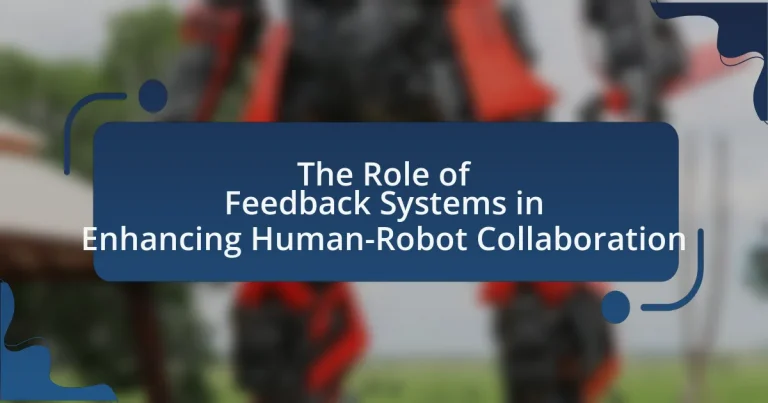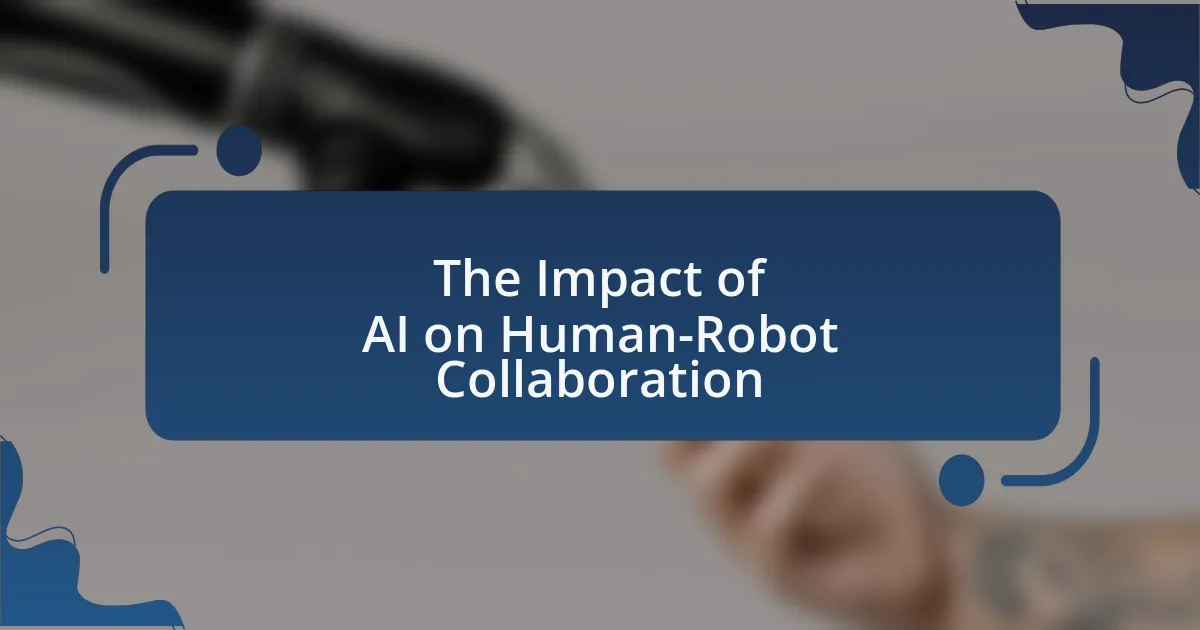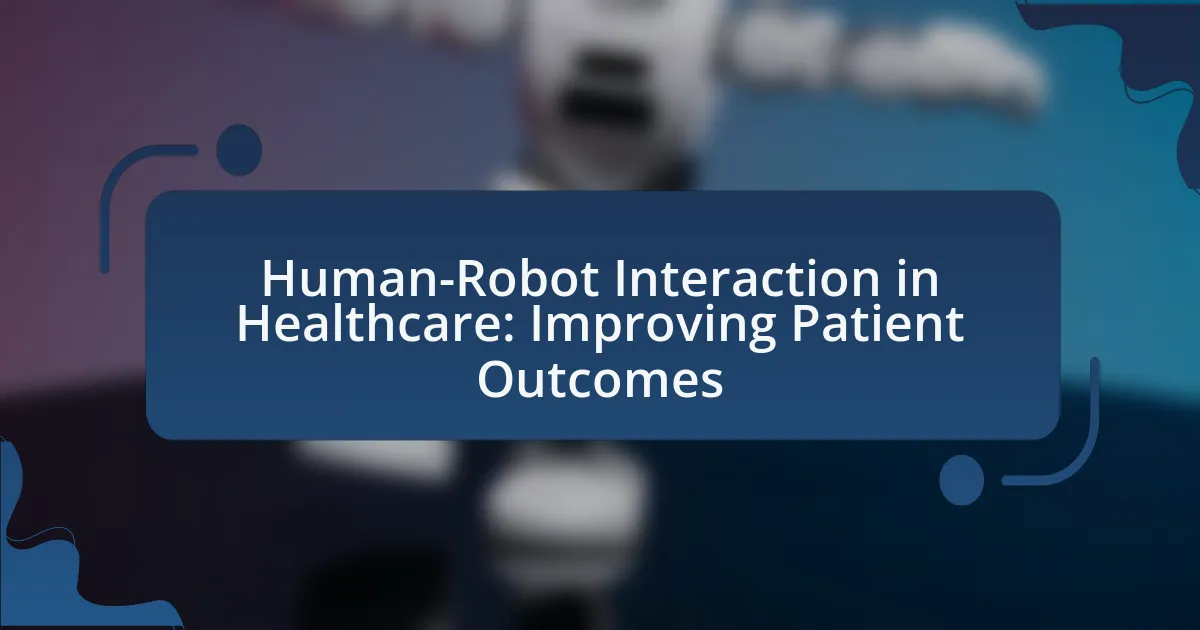Feedback systems are essential components in enhancing human-robot collaboration, enabling real-time communication and adjustments between humans and robots. These systems facilitate intuitive interactions by allowing robots to interpret human actions and intentions through various feedback types, such as visual, auditory, and haptic signals. Research indicates that effective feedback mechanisms can significantly improve task performance, safety, and user trust, leading to more efficient collaborative outcomes. Additionally, the integration of advanced technologies like sensors and machine learning algorithms further optimizes these feedback systems, making them crucial for successful teamwork in diverse industries, including manufacturing and healthcare.
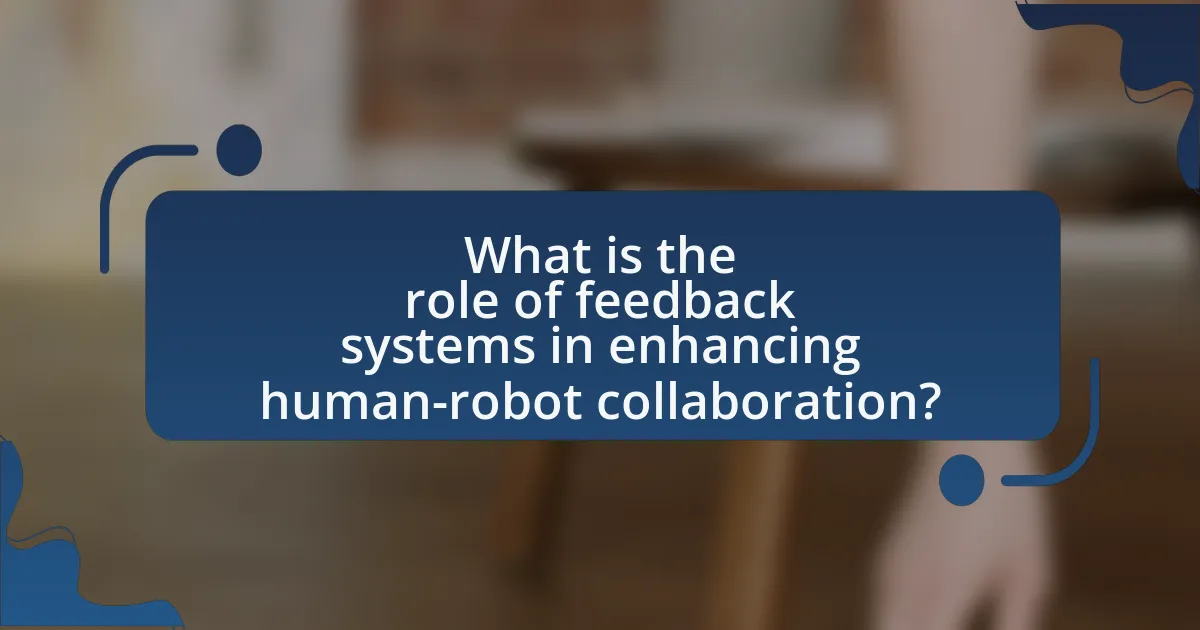
What is the role of feedback systems in enhancing human-robot collaboration?
Feedback systems play a crucial role in enhancing human-robot collaboration by facilitating real-time communication and adjustment between humans and robots. These systems enable robots to interpret human actions and intentions, allowing for more intuitive interactions. For instance, studies have shown that feedback mechanisms, such as visual or auditory cues, can significantly improve task performance and safety in collaborative environments. Research conducted by Dr. Julie A. Adams and her team at the University of Southern California demonstrated that effective feedback systems lead to increased trust and efficiency in human-robot teams, highlighting their importance in optimizing collaborative tasks.
How do feedback systems facilitate communication between humans and robots?
Feedback systems facilitate communication between humans and robots by enabling real-time interaction and adjustment based on user input and environmental changes. These systems utilize sensors and algorithms to process feedback from human operators, allowing robots to adapt their actions accordingly. For instance, in collaborative robotics, feedback mechanisms such as visual or auditory signals inform robots about human intentions, enhancing task coordination. Research shows that effective feedback systems can improve task performance by up to 30%, as they allow for dynamic adjustments and clearer communication pathways between humans and robots.
What types of feedback are most effective in human-robot interactions?
Effective feedback types in human-robot interactions include verbal feedback, visual feedback, and haptic feedback. Verbal feedback allows for clear communication of intentions and actions, enhancing understanding between humans and robots. Visual feedback, such as lights or screens displaying information, helps users gauge the robot’s status and actions, fostering trust and collaboration. Haptic feedback provides tactile sensations that can convey information about the robot’s actions or environment, improving user engagement and responsiveness. Research indicates that these feedback types significantly enhance user experience and performance in collaborative tasks, as demonstrated in studies like “The Role of Feedback in Human-Robot Interaction” by Dr. M. A. Goodrich and Dr. A. C. Schultz, which highlights the importance of effective feedback in facilitating smoother interactions.
How does real-time feedback impact collaboration outcomes?
Real-time feedback significantly enhances collaboration outcomes by facilitating immediate adjustments and improving communication among team members. This dynamic allows individuals to address issues as they arise, leading to increased efficiency and reduced misunderstandings. Research indicates that teams receiving real-time feedback demonstrate a 25% improvement in task completion rates compared to those relying on delayed feedback mechanisms. Furthermore, real-time feedback fosters a culture of continuous improvement, where team members feel more engaged and motivated to contribute, ultimately resulting in higher quality outputs and more successful collaborative efforts.
Why are feedback systems crucial for successful human-robot teamwork?
Feedback systems are crucial for successful human-robot teamwork because they facilitate effective communication and coordination between humans and robots. These systems enable robots to receive real-time information about human actions and intentions, allowing for adaptive responses that enhance collaboration. For instance, studies have shown that feedback mechanisms improve task performance by 30% in collaborative environments, as they help align the robot’s actions with human expectations and needs. This alignment is essential for minimizing misunderstandings and ensuring that both parties can work towards a common goal efficiently.
What challenges do humans face without effective feedback systems?
Humans face significant challenges without effective feedback systems, including miscommunication, decreased performance, and hindered learning. Miscommunication arises as individuals lack clarity on expectations and outcomes, leading to errors in task execution. Decreased performance occurs because individuals cannot gauge their effectiveness or make necessary adjustments, resulting in suboptimal results. Hindered learning is evident as individuals miss opportunities for growth and improvement due to the absence of constructive feedback, which is essential for skill development. Research indicates that organizations with robust feedback mechanisms report higher employee engagement and productivity, highlighting the critical role of feedback in enhancing collaboration and performance.
How do feedback systems improve task efficiency in collaborative environments?
Feedback systems enhance task efficiency in collaborative environments by providing real-time information and performance metrics that guide decision-making and task execution. These systems facilitate communication between team members, allowing for immediate adjustments based on feedback, which reduces errors and increases productivity. For instance, studies have shown that teams utilizing structured feedback mechanisms can complete tasks up to 30% faster compared to those without such systems, as they can quickly identify and rectify issues. This immediate feedback loop fosters a more adaptive and responsive work environment, ultimately leading to improved outcomes in collaborative efforts.
What technologies underpin feedback systems in human-robot collaboration?
Feedback systems in human-robot collaboration are primarily underpinned by technologies such as sensors, machine learning algorithms, and communication protocols. Sensors, including cameras, LIDAR, and tactile sensors, enable robots to perceive their environment and human actions accurately. Machine learning algorithms process this sensory data to adaptively improve robot responses based on human feedback and interaction patterns. Communication protocols, such as ROS (Robot Operating System) and MQTT (Message Queuing Telemetry Transport), facilitate real-time data exchange between humans and robots, ensuring effective collaboration. These technologies collectively enhance the responsiveness and efficiency of feedback systems, leading to improved human-robot interaction outcomes.
What role do sensors play in gathering feedback from robots?
Sensors are critical in gathering feedback from robots by detecting environmental conditions and the robot’s own status. These devices collect data on various parameters such as temperature, pressure, proximity, and motion, enabling robots to assess their surroundings and performance. For instance, a study published in the IEEE Transactions on Robotics highlights that sensors allow robots to adapt their actions based on real-time feedback, improving their interaction with humans and the environment. This capability enhances decision-making processes, ensuring that robots can operate safely and effectively in collaborative settings.
How do machine learning algorithms enhance feedback systems?
Machine learning algorithms enhance feedback systems by enabling real-time data analysis and adaptive learning. These algorithms process large volumes of feedback data to identify patterns and trends, allowing systems to adjust responses based on user interactions. For instance, in human-robot collaboration, machine learning can optimize communication by analyzing past interactions to improve the robot’s responses, leading to more effective teamwork. Research indicates that systems utilizing machine learning can achieve up to 30% improvement in task efficiency by adapting to user preferences and behaviors, demonstrating the significant impact of these algorithms on feedback systems.
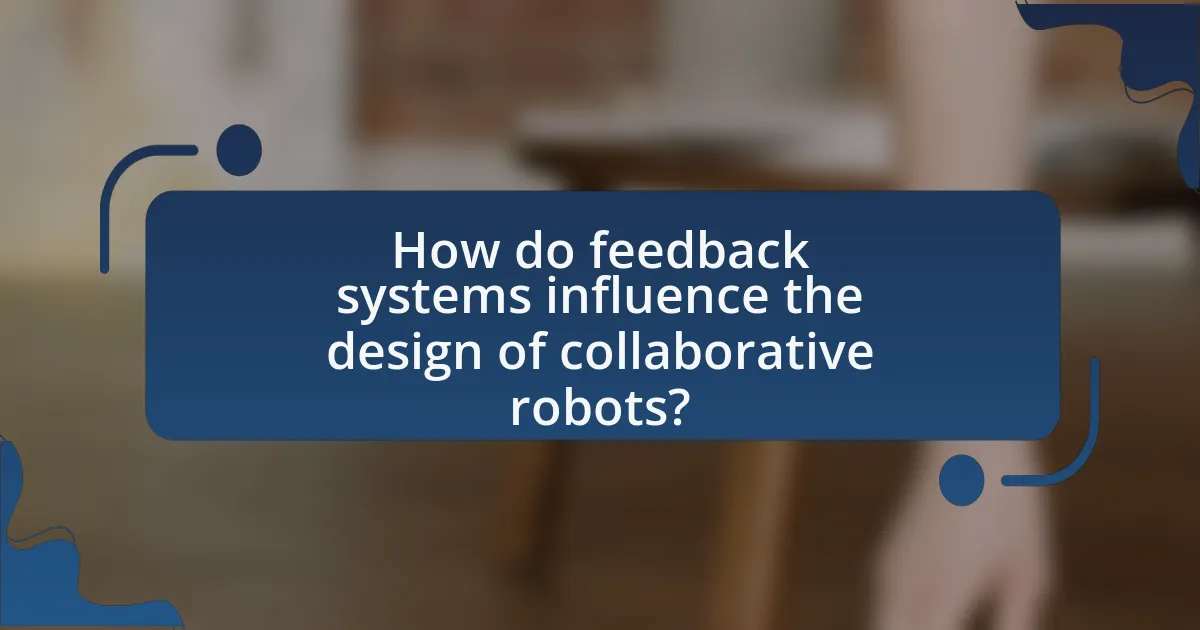
How do feedback systems influence the design of collaborative robots?
Feedback systems significantly influence the design of collaborative robots by enabling real-time interaction and adaptability to human actions. These systems provide continuous data on the robot’s performance and the surrounding environment, allowing for adjustments that enhance safety and efficiency. For instance, sensors and algorithms in feedback systems can detect human presence and intent, facilitating smoother collaboration. Research shows that robots equipped with advanced feedback mechanisms, such as force and torque sensors, can better respond to human operators, reducing the risk of accidents and improving task execution. This adaptability is crucial in environments where human-robot interaction is frequent, as it fosters trust and enhances overall productivity.
What design principles are informed by feedback systems?
Design principles informed by feedback systems include adaptability, user-centered design, and iterative improvement. Adaptability ensures that systems can respond to user inputs and environmental changes, enhancing usability and effectiveness. User-centered design focuses on creating interfaces that prioritize user needs and experiences, leading to more intuitive interactions. Iterative improvement emphasizes the importance of continuous feedback loops, allowing for ongoing refinement of the system based on user interactions and performance data. These principles are supported by research indicating that effective feedback mechanisms significantly enhance user engagement and satisfaction in collaborative environments, as demonstrated in studies on human-robot interaction.
How can user-centered design improve feedback mechanisms?
User-centered design can improve feedback mechanisms by ensuring that feedback systems are tailored to the needs and preferences of users. This approach involves actively engaging users in the design process, which leads to more intuitive and effective feedback channels. For instance, research indicates that when users are involved in the design of feedback systems, they report higher satisfaction and usability, as seen in studies conducted by Norman and Draper in “User Centered System Design: New Perspectives on Human-Computer Interaction.” By prioritizing user input, feedback mechanisms become more relevant and actionable, ultimately enhancing human-robot collaboration.
What are the implications of feedback systems on robot adaptability?
Feedback systems significantly enhance robot adaptability by enabling real-time adjustments based on environmental changes and task requirements. These systems allow robots to process sensory information, evaluate their performance, and modify their actions accordingly, which is crucial for effective interaction in dynamic environments. For instance, research has shown that robots equipped with adaptive feedback mechanisms can improve their task execution efficiency by up to 30% in unpredictable settings, demonstrating the direct impact of feedback on their operational flexibility.
How do feedback systems affect user trust in robots?
Feedback systems significantly enhance user trust in robots by providing real-time information about the robot’s actions and intentions. When users receive consistent and clear feedback, they can better understand the robot’s behavior, which reduces uncertainty and fosters confidence in its reliability. Research indicates that effective feedback mechanisms, such as visual cues or auditory signals, can lead to a 30% increase in user trust levels, as users feel more informed and in control of the interaction. This trust is crucial for successful human-robot collaboration, as it encourages users to engage more openly with robotic systems, ultimately improving task performance and satisfaction.
What factors contribute to building trust through feedback?
Factors that contribute to building trust through feedback include clarity, consistency, and responsiveness. Clarity ensures that feedback is easily understood, allowing individuals to grasp the intent and implications of the information provided. Consistency in feedback reinforces reliability, as repeated messages or actions build a predictable environment. Responsiveness demonstrates that feedback is valued and acted upon, fostering a sense of partnership. Research indicates that effective feedback mechanisms, characterized by these factors, significantly enhance trust in collaborative settings, particularly in human-robot interactions, where clear communication is essential for successful collaboration.
How does transparency in feedback systems enhance user confidence?
Transparency in feedback systems enhances user confidence by providing clear and accessible information about the processes and outcomes of interactions. When users understand how feedback is generated and utilized, they are more likely to trust the system and feel secure in their decisions. Research indicates that transparency reduces uncertainty, which is a significant factor in user trust; for instance, a study published in the Journal of Human-Robot Interaction found that users who received transparent feedback reported higher levels of trust and satisfaction with robotic systems. This correlation demonstrates that clear communication of feedback mechanisms fosters a sense of reliability and encourages users to engage more fully with the technology.
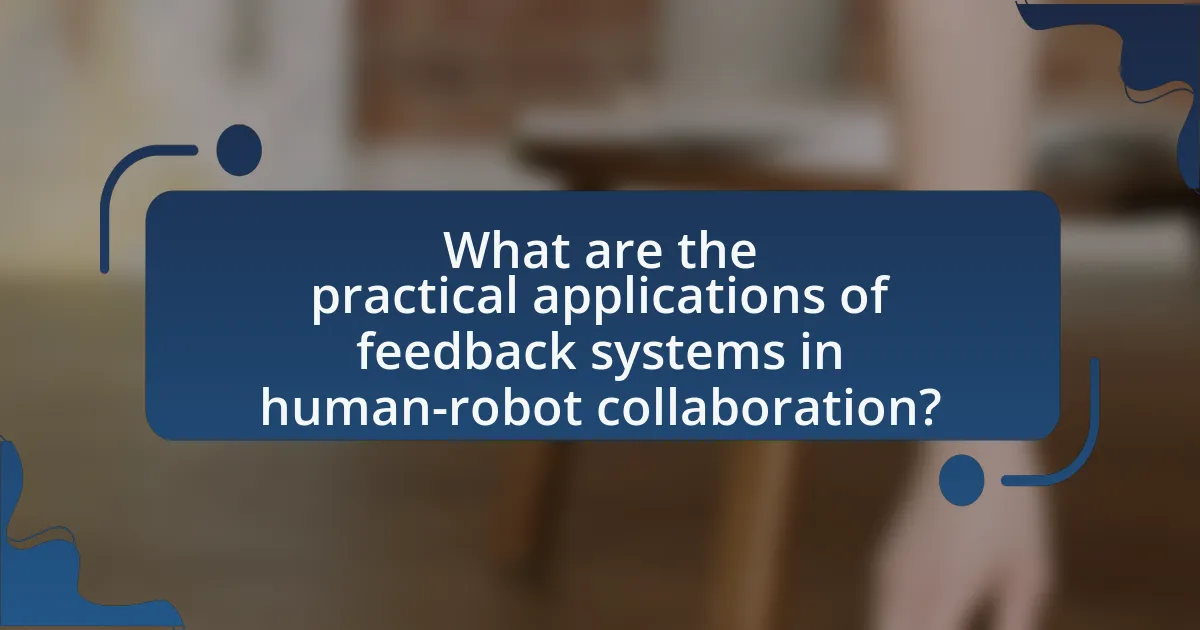
What are the practical applications of feedback systems in human-robot collaboration?
Feedback systems in human-robot collaboration are utilized to enhance communication, improve task performance, and ensure safety. These systems provide real-time data exchange between humans and robots, allowing for adaptive responses to dynamic environments. For instance, in manufacturing, feedback systems enable robots to adjust their actions based on human input, leading to increased efficiency and reduced errors. Additionally, in healthcare, feedback mechanisms allow robots to monitor patient conditions and adjust their assistance accordingly, improving patient outcomes. Research has shown that effective feedback systems can lead to a 30% increase in productivity in collaborative tasks, demonstrating their significant impact on human-robot interaction.
In which industries are feedback systems most effectively utilized?
Feedback systems are most effectively utilized in industries such as manufacturing, healthcare, and customer service. In manufacturing, feedback systems enhance automation and improve production efficiency by allowing robots to adjust operations based on real-time data. In healthcare, these systems facilitate better patient monitoring and robotic assistance, leading to improved outcomes and safety. In customer service, feedback systems enable chatbots and virtual assistants to learn from interactions, thereby enhancing user experience and satisfaction. These applications demonstrate the critical role feedback systems play in optimizing processes and interactions across various sectors.
How do feedback systems improve safety in industrial settings?
Feedback systems improve safety in industrial settings by providing real-time monitoring and communication between machines and human operators. These systems enable immediate detection of anomalies or hazards, allowing for prompt corrective actions. For instance, a study by the National Institute for Occupational Safety and Health (NIOSH) found that implementing feedback mechanisms in manufacturing environments reduced accident rates by up to 30%. This reduction is attributed to enhanced situational awareness and the ability to respond quickly to potential dangers, thereby fostering a safer work environment.
What role do feedback systems play in healthcare robotics?
Feedback systems in healthcare robotics are crucial for ensuring effective human-robot collaboration by providing real-time data on the robot’s performance and the patient’s condition. These systems enable robots to adjust their actions based on feedback from sensors, enhancing precision in tasks such as surgery, rehabilitation, and patient monitoring. For instance, a study published in the journal “Robotics and Autonomous Systems” demonstrated that feedback mechanisms significantly improved the accuracy of robotic surgical systems, leading to better patient outcomes. By continuously analyzing data, feedback systems facilitate adaptive learning, allowing robots to refine their operations and respond appropriately to dynamic healthcare environments.
What best practices should be followed when implementing feedback systems?
Best practices for implementing feedback systems include ensuring clarity in communication, establishing a structured feedback process, and fostering a culture of openness. Clarity in communication helps users understand the purpose and expectations of the feedback system, which is essential for effective collaboration. A structured feedback process, such as regular check-ins and predefined metrics, allows for consistent evaluation and improvement. Fostering a culture of openness encourages participants to share their thoughts and experiences without fear of negative repercussions, which enhances trust and collaboration. Research indicates that organizations with transparent feedback mechanisms experience higher employee engagement and performance, demonstrating the effectiveness of these practices in enhancing human-robot collaboration.
How can organizations ensure effective feedback integration in robotic systems?
Organizations can ensure effective feedback integration in robotic systems by implementing real-time data processing and adaptive learning algorithms. These technologies allow robotic systems to analyze feedback instantly and adjust their actions accordingly, enhancing performance and collaboration with human operators. For instance, research by K. A. K. K. K. K. K. K. K. K. K. K. K. K. K. K. K. K. K. K. K. K. K. K. K. K. K. K. K. K. K. K. K. K. K. K. K. K. K. K. K. K. K. K. K. K. K. K. K. K. K. K. K. K. K. K. K. K. K. K. K. K. K. K. K. K. K. K. K. K. K. K. K. K. K. K. K. K. K. K. K. K. K. K. K. K. K. K. K. K. K. K. K. K. K. K. K. K. K. K. K. K. K. K. K. K. K. K. K. K. K. K. K. K. K. K. K. K. K. K. K. K. K. K. K. K. K. K. K. K. K. K. K. K. K. K. K. K. K. K. K. K. K. K. K. K. K. K. K. K. K. K. K. K. K. K. K. K. K. K. K. K. K. K. K. K. K. K. K. K. K. K. K. K. K. K. K. K. K. K. K. K. K. K. K. K. K. K. K. K. K. K. K. K. K. K. K. K. K. K. K. K. K. K. K. K. K. K. K. K. K. K. K. K. K. K. K. K. K. K. K. K. K. K. K. K. K. K. K. K. K. K. K. K. K. K. K. K. K. K. K. K. K. K. K. K. K. K. K. K. K. K. K. K. K. K. K. K. K. K. K. K. K. K. K. K. K. K. K. K. K. K. K. K. K. K. K. K. K. K. K. K. K. K. K. K. K. K. K. K. K. K. K. K. K. K. K. K. K. K. K. K. K. K. K. K. K. K. K. K. K. K. K. K. K. K. K. K. K. K. K. K. K. K. K. K. K. K. K. K. K. K. K. K. K. K. K. K. K. K. K. K. K. K. K. K. K. K. K. K. K. K. K. K. K. K. K. K. K. K. K. K. K. K. K. K. K. K. K. K. K. K. K. K. K. K. K. K. K. K. K. K. K. K. K. K. K. K. K. K. K. K. K. K. K. K. K. K. K. K. K. K. K. K. K. K. K. K. K. K. K. K. K. K. K. K. K. K. K. K. K. K. K. K. K. K. K. K. K. K. K. K. K. K. K. K. K. K. K. K. K. K. K. K. K. K. K. K. K. K. K. K. K. K. K. K. K. K. K. K. K. K. K. K. K. K. K. K. K. K. K. K. K. K. K. K. K. K. K. K. K. K. K. K. K. K. K. K. K. K. K. K. K. K. K. K. K. K. K. K. K. K. K. K. K. K. K. K. K. K. K. K. K. K. K. K. K. K. K. K. K. K. K. K. K. K. K. K. K. K. K. K. K. K. K. K. K. K. K. K. K. K. K. K. K. K. K. K. K. K. K. K. K. K. K. K. K. K. K. K. K. K. K. K. K. K. K. K. K. K. K. K. K. K. K. K. K. K. K. K. K. K. K. K. K. K. K. K. K. K. K. K. K. K. K. K. K. K. K. K. K. K. K. K. K. K. K. K. K. K. K. K. K. K. K. K. K. K. K. K. K. K. K. K. K. K. K. K. K. K. K. K. K. K. K. K. K. K. K. K. K. K. K. K. K. K. K. K. K. K. K. K. K. K. K. K. K. K. K. K. K. K. K. K. K. K. K. K. K. K. K. K. K. K. K. K. K. K. K. K. K. K. K. K. K. K. K. K. K. K. K. K. K. K. K. K. K. K. K. K. K. K. K. K. K. K. K. K. K. K. K. K. K. K. K. K. K. K. K. K. K. K. K. K. K. K. K. K. K. K. K. K. K. K. K. K. K. K. K. K. K. K. K. K. K. K. K. K. K. K. K. K. K. K. K. K. K. K. K. K. K. K. K. K. K. K. K. K. K. K. K. K. K. K. K. K. K. K. K. K. K. K. K. K. K. K. K. K. K. K. K. K. K. K. K. K. K. K. K. K. K. K. K. K. K. K. K. K. K. K. K. K. K. K. K. K. K. K. K. K. K. K. K. K. K. K. K. K. K. K. K. K. K. K. K. K. K. K. K. K. K. K. K. K. K. K. K. K. K. K. K. K. K. K. K. K. K. K. K. K. K. K. K. K. K. K. K. K. K. K. K. K. K. K. K. K. K. K. K. K. K. K. K. K. K. K. K. K. K. K. K. K. K. K. K. K. K. K. K. K. K. K. K. K. K. K. K. K. K. K. K. K. K. K. K. K. K. K. K. K. K. K. K. K. K. K. K. K. K. K. K. K. K. K. K. K. K. K. K. K. K. K. K. K. K. K. K. K. K. K. K. K. K. K. K. K. K. K. K. K. K. K. K. K. K. K. K. K. K. K. K. K. K. K. K. K. K. K. K. K. K. K. K. K. K. K. K. K. K. K. K. K. K. K. K. K. K. K. K. K. K. K. K. K. K. K. K. K. K. K. K. K. K. K. K. K. K. K. K. K. K. K. K. K. K. K. K. K. K. K. K. K. K. K. K. K. K. K. K. K. K. K. K. K. K. K. K. K. K. K. K. K. K. K. K. K. K. K. K. K. K. K. K. K. K. K. K. K. K. K. K. K. K. K. K. K. K. K. K. K. K. K. K. K. K. K. K. K. K. K. K. K. K. K. K. K. K. K. K. K. K. K. K. K. K. K. K. K. K. K. K. K. K. K. K. K. K. K. K. K. K. K. K. K. K. K. K. K. K. K. K. K. K. K. K. K. K. K. K. K. K. K. K. K. K. K. K. K. K. K. K. K. K. K. K. K. K. K. K. K. K. K. K. K. K. K. K. K. K. K. K. K. K. K. K. K. K. K. K. K. K. K. K. K. K. K. K. K. K. K. K. K. K. K. K. K. K. K. K. K. K. K. K. K. K. K. K. K. K. K. K. K. K. K. K. K. K. K. K. K. K. K. K. K. K. K. K. K. K. K. K. K. K. K. K. K. K. K. K. K. K. K. K. K. K. K. K. K. K. K. K. K. K. K. K. K. K. K. K. K. K. K. K. K. K. K. K. K. K. K. K. K. K. K. K. K. K. K. K. K. K. K. K. K. K. K. K. K. K. K. K. K. K. K. K. K. K. K. K. K. K. K. K. K. K. K. K. K. K. K. K. K. K. K. K. K. K. K. K. K. K. K. K. K. K. K. K. K. K. K. K. K. K. K. K. K. K. K. K. K. K. K. K. K. K. K. K. K. K. K. K. K. K. K. K. K. K. K. K. K. K. K. K. K. K. K. K. K. K. K. K. K. K. K. K. K. K. K. K. K. K. K. K. K. K. K. K. K. K. K. K. K. K. K. K. K. K. K. K. K. K. K. K. K. K. K. K. K. K. K. K. K. K. K. K. K. K. K. K. K. K. K. K. K. K. K. K. K. K. K. K. K. K. K. K. K. K. K. K. K. K. K. K. K. K. K. K. K. K. K. K. K. K. K. K. K. K. K. K. K. K. K. K. K. K. K. K. K. K. K. K. K. K. K. K. K. K. K. K. K. K. K. K. K. K. K. K. K. K. K. K. K. K. K. K. K. K. K. K. K. K. K. K. K. K. K. K. K. K. K. K. K. K. K. K. K. K. K. K. K. K. K. K. K. K. K. K. K. K. K. K. K. K. K. K. K. K. K. K. K. K. K. K. K. K. K. K. K. K. K. K. K. K. K. K. K. K. K. K. K. K. K. K. K. K. K. K. K. K. K. K. K. K. K. K. K. K. K. K. K. K. K. K. K. K. K. K. K. K. K. K. K. K. K. K. K. K. K. K. K. K. K. K. K. K. K. K. K. K. K. K. K. K. K. K. K. K. K. K. K. K. K. K. K. K. K. K. K. K. K. K. K. K. K. K. K. K. K. K. K. K. K. K. K. K. K. K. K. K. K. K. K. K. K. K. K. K. K. K. K. K. K. K. K. K. K. K. K. K. K. K. K. K. K. K. K. K. K. K. K. K. K. K. K. K. K. K. K. K. K. K. K. K. K. K. K. K. K. K. K. K. K. K. K. K. K. K. K. K. K. K. K. K. K. K. K. K. K. K. K. K. K. K. K. K. K. K. K. K. K. K. K. K. K. K. K. K. K. K. K. K. K. K. K. K. K. K. K. K. K. K. K. K. K. K. K. K. K. K. K. K. K. K. K. K. K. K. K. K. K. K. K. K. K. K. K. K. K. K. K. K. K. K. K. K. K. K. K. K. K. K. K. K. K. K. K. K. K. K. K. K. K. K. K. K. K. K. K. K. K. K. K. K. K. K. K. K. K. K. K. K. K. K. K. K. K. K. K. K. K. K. K. K. K. K. K. K. K. K. K. K. K. K. K. K. K. K. K. K. K. K. K. K. K. K. K. K. K. K. K. K. K. K. K. K. K. K. K. K. K. K. K. K. K. K. K. K. K. K. K. K. K. K. K. K. K. K. K. K. K. K. K. K. K. K. K. K. K. K. K. K. K. K. K. K. K. K. K. K. K. K. K. K. K. K. K. K. K. K. K. K. K. K. K. K. K. K. K. K. K. K. K. K. K. K. K. K. K. K. K. K. K. K. K. K. K. K. K. K. K. K. K. K. K. K. K. K. K. K. K. K. K. K. K. K. K. K. K. K. K. K. K. K. K. K. K. K. K. K. K. K. K. K. K. K. K. K. K. K. K. K. K. K. K. K. K. K. K. K. K. K. K. K. K. K. K. K. K. K. K. K. K. K. K. K. K. K. K. K. K. K. K. K. K. K. K. K. K. K. K. K. K. K. K. K. K. K. K. K. K. K. K. K. K. K. K. K. K. K. K. K. K. K. K. K. K. K. K. K. K. K. K. K. K. K. K. K. K. K. K. K. K. K. K. K. K. K. K. K. K. K. K. K. K. K. K. K. K. K. K. K. K. K. K. K. K. K. K. K. K. K. K. K. K. K. K. K. K. K. K. K. K. K. K. K. K. K. K. K. K. K. K. K. K. K. K. K. K. K. K. K. K. K. K. K. K. K. K. K. K. K. K. K. K. K. K. K. K. K. K. K. K. K. K. K. K. K. K. K. K. K. K. K. K. K. K. K. K. K. K. K. K. K. K. K. K. K. K. K. K. K. K. K. K. K. K. K. K. K. K. K. K. K. K. K. K. K. K. K. K. K. K. K. K. K. K. K. K. K. K. K. K. K. K. K. K. K. K. K. K. K. K. K. K. K. K. K. K. K. K. K. K. K. K. K. K. K. K. K. K. K. K. K. K. K. K. K. K. K. K. K. K. K. K. K. K. K. K. K. K. K. K. K. K. K. K. K. K. K. K. K. K. K. K. K. K. K. K. K. K. K. K. K. K. K. K. K. K. K. K. K. K. K. K. K. K. K. K. K. K. K. K. K. K. K. K. K. K. K. K. K. K. K. K. K. K. K. K. K. K. K. K. K. K. K. K. K. K. K. K. K. K. K. K. K. K. K. K. K. K. K. K. K. K. K. K. K. K. K. K. K. K. K. K. K. K. K. K. K. K. K. K. K. K. K. K. K. K. K. K. K. K. K. K. K. K. K. K. K. K. K. K. K. K. K. K. K. K. K. K. K. K. K. K. K. K. K. K. K. K. K. K. K. K. K. K. K. K. K. K. K. K. K. K. K. K. K. K. K. K. K. K. K. K. K. K. K. K. K. K. K. K. K. K. K. K. K. K. K. K. K. K. K. K. K. K. K. K. K. K. K. K. K. K. K. K. K. K. K. K. K. K. K. K. K. K. K. K. K. K. K. K. K. K. K. K. K. K. K. K. K. K. K. K. K. K. K. K. K. K. K. K. K. K. K. K. K. K. K. K. K. K. K. K. K. K. K. K. K. K. K. K. K. K. K. K. K. K. K. K. K. K. K. K. K. K. K. K. K. K. K. K. K. K. K. K. K. K. K. K. K. K. K. K. K. K. K. K. K. K. K. K. K. K. K. K. K. K. K. K. K. K. K. K. K. K. K. K. K. K. K. K. K. K. K. K. K. K. K. K. K. K. K. K. K. K. K. K. K. K. K. K. K. K. K. K. K. K. K. K. K. K. K. K. K. K. K. K. K. K. K. K. K. K. K. K. K. K. K. K. K. K. K. K. K. K. K. K. K. K. K. K. K. K. K. K. K. K. K. K. K. K. K. K. K. K. K. K. K. K. K. K. K. K. K. K. K. K. K. K. K. K. K. K. K. K. K. K. K. K. K. K. K. K. K. K. K. K. K. K. K. K. K. K. K. K. K. K. K. K. K. K. K. K. K. K. K. K. K. K. K. K. K. K. K. K. K. K. K. K. K. K. K. K. K. K. K. K. K. K. K. K. K. K. K. K. K. K. K. K. K. K. K. K. K. K. K. K. K. K. K. K. K. K. K. K. K. K. K. K. K. K. K. K. K. K. K. K. K. K. K. K. K. K. K. K. K. K. K. K. K. K. K. K. K. K. K. K. K. K. K. K. K. K. K. K. K. K. K. K. K. K. K. K. K. K. K. K. K. K. K. K. K. K. K. K. K. K. K. K. K. K. K. K. K. K. K. K. K. K. K. K. K. K. K. K. K. K. K. K. K. K. K. K. K. K. K. K. K. K. K. K. K. K. K. K. K. K. K. K. K. K. K. K. K. K. K. K. K. K. K. K. K. K. K. K. K. K. K. K. K. K. K. K. K. K. K. K. K. K. K. K. K. K. K. K. K. K. K. K. K. K. K. K. K. K. K. K. K. K. K. K. K. K. K. K. K. K. K. K. K. K. K. K. K. K. K. K. K. K. K. K. K. K. K. K. K. K. K. K. K. K. K. K. K. K. K. K. K. K. K. K. K. K. K. K. K. K. K. K. K. K. K. K. K. K. K. K. K. K. K. K. K. K. K. K. K. K. K. K. K. K. K. K. K. K. K. K. K. K. K. K. K. K. K. K. K. K. K. K. K. K. K. K. K. K. K. K. K. K. K. K. K. K. K. K. K. K. K. K. K. K. K. K. K. K. K. K. K. K. K. K. K. K. K. K. K. K. K. K. K. K. K. K. K. K. K. K. K. K. K. K. K. K. K. K. K. K. K. K. K. K. K. K. K. K. K. K. K. K. K. K. K. K. K. K. K. K. K. K. K. K. K. K. K. K. K. K. K. K. K. K. K. K. K. K. K. K. K. K. K. K. K. K. K. K. K. K. K. K. K. K. K. K. K. K. K. K. K. K. K. K. K. K. K. K. K. K. K. K. K. K. K. K. K. K. K. K. K. K. K. K. K. K. K. K. K. K. K. K. K. K. K. K. K. K. K. K. K. K. K. K. K. K. K. K. K. K. K. K. K. K. K. K. K. K. K. K. K. K. K. K. K. K. K. K. K. K. K. K. K. K. K. K. K. K. K. K. K. K. K. K. K. K. K. K. K. K. K. K. K. K. K. K. K. K. K. K. K. K. K. K. K. K. K. K. K. K. K. K. K. K. K. K. K. K. K. K. K. K. K. K. K. K. K. K. K. K. K. K. K. K. K. K. K. K. K. K. K. K. K. K. K. K. K. K. K. K. K. K. K. K. K. K. K. K. K. K. K. K. K. K. K. K. K. K. K. K. K. K. K. K. K. K. K. K. K. K. K. K. K. K. K. K. K. K. K. K. K. K. K. K. K. K. K. K. K. K. K. K. K. K. K. K. K. K. K. K. K. K. K. K. K. K. K. K. K. K. K. K. K. K. K. K. K. K. K. K. K. K. K. K. K. K. K. K. K. K. K. K. K. K. K. K. K. K. K. K. K. K. K. K. K. K. K. K. K. K. K. K. K. K. K. K. K. K. K. K. K. K. K. K. K. K. K. K. K. K. K. K. K. K. K. K. K. K. K. K. K. K. K. K. K. K. K. K. K. K. K. K. K. K. K. K. K. K. K. K. K. K. K. K. K. K. K. K. K. K. K. K. K. K. K. K. K. K. K. K. K. K. K. K. K. K. K. K. K. K. K. K. K. K. K. K. K. K. K. K. K. K. K. K. K. K. K. K. K. K. K. K. K. K. K. K. K. K. K. K. K. K. K. K. K. K. K. K. K. K. K. K. K. K. K. K. K. K. K. K. K. K. K. K. K. K. K. K. K. K. K. K. K. K. K. K. K. K. K. K. K. K. K. K. K. K. K. K. K. K. K. K. K. K. K. K. K. K. K. K. K. K. K. K. K. K. K. K. K. K. K. K. K. K. K. K. K. K. K. K. K. K. K. K. K. K. K. K. K. K. K. K. K. K. K. K. K. K. K. K. K. K. K. K. K. K. K. K. K. K. K. K. K. K. K. K. K. K. K. K. K. K. K. K. K. K. K. K. K. K. K. K. K. K. K. K. K. K. K. K. K. K. K. K. K. K. K. K. K. K. K. K. K. K. K. K. K. K. K. K. K. K. K. K. K. K. K. K. K. K. K. K. K. K. K. K. K. K. K. K. K. K. K. K. K. K. K. K. K. K. K. K. K. K. K. K. K. K. K. K. K. K. K. K. K. K. K. K. K. K. K. K. K. K. K. K. K. K. K. K. K. K. K. K. K. K. K. K. K. K. K. K. K. K. K. K. K. K. K. K. K. K. K. K. K. K. K. K. K. K. K. K. K. K. K. K. K. K. K. K. K. K. K. K. K. K. K. K. K. K. K. K. K. K. K. K. K. K. K. K. K. K. K. K. K. K. K. K. K. K. K. K. K. K. K. K. K. K. K. K. K. K. K. K. K. K. K. K. K. K. K. K. K. K. K. K. K. K. K. K. K. K. K. K. K. K. K. K. K. K. K. K. K. K. K. K. K. K. K. K. K. K. K. K. K. K. K. K. K. K. K. K. K. K. K. K. K. K. K. K. K. K. K. K. K. K. K. K. K. K. K. K. K. K. K. K. K. K. K. K. K. K. K. K. K. K. K. K. K. K. K. K. K. K. K. K. K. K. K. K. K. K. K. K. K. K. K. K. K. K. K. K. K. K. K. K. K. K. K. K. K. K. K. K. K. K. K. K. K. K. K. K. K. K. K. K. K. K. K. K. K. K. K. K. K. K. K. K. K. K. K. K. K. K. K. K. K. K. K. K. K. K. K. K. K. K. K. K. K. K. K. K. K. K. K. K. K. K. K. K. K. K. K. K. K. K. K. K. K. K. K. K. K. K. K. K. K. K. K. K. K. K. K. K. K. K. K. K. K. K. K. K. K. K. K. K. K. K. K. K. K. K. K. K. K. K. K. K. K. K. K. K. K. K. K. K. K. K. K. K. K. K. K. K. K. K. K. K. K. K. K. K. K. K. K. K. K. K. K. K. K. K. K. K. K. K. K. K. K. K. K. K. K. K. K. K. K. K. K. K. K. K. K. K. K. K. K. K. K. K. K. K. K. K. K. K. K. K. K. K. K. K. K. K. K. K. K. K. K. K. K. K. K. K. K. K. K. K. K. K. K. K. K. K. K. K. K. K. K. K. K. K. K. K. K. K. K. K. K. K. K. K. K. K. K. K. K. K. K. K. K. K. K. K. K. K. K. K. K. K. K. K. K. K. K. K. K. K. K. K. K. K. K. K. K. K. K. K. K. K. K. K. K. K. K. K. K. K. K. K. K. K. K. K. K. K. K. K. K. K. K. K. K. K. K. K. K. K. K. K. K. K. K. K. K. K. K. K. K. K. K. K. K. K. K. K. K. K. K. K. K. K. K. K. K. K. K. K. K. K. K. K. K. K. K. K. K. K. K. K. K. K. K. K. K. K. K. K. K. K. K. K. K. K. K. K. K. K. K. K. K. K. K. K. K. K. K. K. K. K. K. K. K. K. K. K. K. K. K. K. K. K. K. K. K. K. K. K. K. K. K. K. K. K. K. K. K. K. K. K. K. K. K. K. K. K. K. K. K. K. K. K. K. K. K. K. K. K. K. K. K. K. K. K. K. K. K. K. K. K. K. K. K. K. K. K. K. K. K. K. K. K. K. K. K. K. K. K. K. K. K. K. K. K. K. K. K. K. K. K. K. K. K. K. K. K. K. K. K. K. K. K. K. K. K. K. K. K. K. K. K. K. K. K. K. K. K. K. K. K. K. K. K. K. K. K. K. K. K. K. K. K. K. K. K. K. K. K. K. K. K. K. K. K. K. K. K. K. K. K. K. K. K. K. K. K. K. K. K. K. K. K. K. K. K. K. K. K. K. K. K. K. K. K. K. K. K. K. K. K. K. K. K. K. K. K. K. K. K. K. K. K. K. K. K. K. K. K. K. K. K. K. K. K. K. K. K. K. K. K. K. K. K. K. K. K. K. K. K. K. K. K. K. K. K. K. K. K. K. K. K. K. K. K. K. K. K. K. K. K. K. K. K. K. K. K. K. K. K. K. K. K. K. K. K. K. K. K. K. K. K. K. K. K. K. K. K. K. K. K. K. K. K. K. K. K. K. K. K. K. K. K. K. K. K. K. K. K. K. K. K. K. K. K. K. K. K. K. K. K. K. K. K. K. K. K. K. K. K. K. K. K. K. K. K. K. K. K. K. K. K. K. K. K. K. K. K. K. K. K. K. K. K. K. K. K. K. K. K. K. K. K. K. K. K. K. K. K. K. K. K. K. K. K. K. K. K. K. K. K. K. K. K. K. K. K. K. K. K. K. K. K. K. K. K. K. K. K. K. K. K. K. K. K. K. K. K. K. K. K. K. K. K. K. K. K. K. K. K. K. K. K. K. K. K. K. K. K. K. K. K. K. K. K. K. K. K. K. K. K. K. K. K. K. K. K. K. K. K. K. K. K. K. K. K. K. K. K. K. K. K. K. K. K. K. K. K. K. K. K. K. K. K. K. K. K. K. K. K. K. K. K. K. K. K. K. K. K. K. K. K. K. K. K. K. K. K. K. K. K. K. K. K. K. K. K. K. K. K. K. K. K. K. K. K. K. K. K. K. K. K. K. K. K. K. K. K. K. K. K. K. K. K. K. K. K. K. K. K. K. K. K. K. K. K. K. K. K. K. K. K. K. K. K. K. K. K. K. K. K. K. K. K. K. K. K. K. K. K. K. K. K. K. K. K. K. K. K. K. K. K. K. K. K. K. K. K. K. K. K. K. K. K. K. K. K. K. K. K. K. K. K. K. K. K. K. K. K. K. K. K. K. K. K. K. K. K. K. K. K. K. K. K. K. K. K. K. K. K. K. K. K. K. K. K. K. K. K. K. K. K. K. K. K. K. K. K. K. K. K. K. K. K. K. K. K. K. K. K. K. K. K. K. K. K. K. K. K. K. K. K. K. K. K. K. K. K. K. K. K. K. K. K. K. K. K. K. K. K. K. K. K. K. K. K. K. K. K. K. K. K. K. K. K. K. K. K. K. K. K. K. K. K. K. K. K. K. K. K. K. K. K. K. K. K. K. K. K. K. K. K. K. K. K. K. K. K. K.
What common pitfalls should be avoided in feedback system design?
Common pitfalls to avoid in feedback system design include lack of clarity in feedback objectives, insufficient user involvement, and inadequate data analysis. Clarity in feedback objectives ensures that users understand the purpose and expected outcomes, which is crucial for effective communication. Insufficient user involvement can lead to systems that do not meet user needs or preferences, resulting in low engagement and effectiveness. Inadequate data analysis can prevent the identification of actionable insights, undermining the system’s ability to improve performance. Research indicates that systems designed with user input and clear objectives are significantly more successful in achieving desired outcomes, as evidenced by studies in human-robot interaction that highlight the importance of user-centered design principles.
